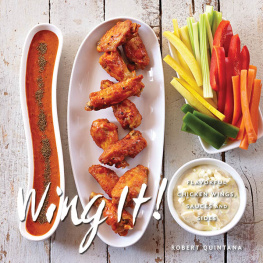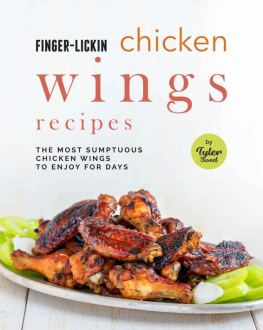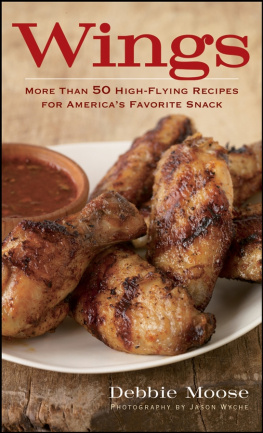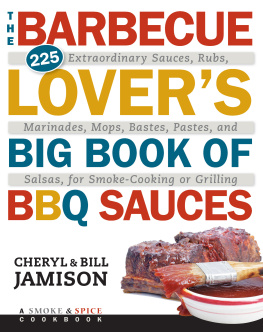Preface
What is it about eating chicken wings that gets people all excited? Over the last decade the popularity of wings has soared. When I roast a chicken, the first part I love to eat are the wings. The use of chicken wings and drumettes has gained a huge following by both young and old and on restaurant menus. The reasons are simple; chicken is what I refer to as the empty canvas. The range of recipes can satisfy most every palate; from local flavors like smoke and barbecue, to more exotic international spices like curry and Moroccan ras el hanout . Everyone has a favorite flavor and looks for a new version to excite the daily routine or impress partygoers. This is where the experimentation and personal preferences come into play. Taking the ordinary and making it extraordinary! Layering flavor as one would paint.
My chicken wing focus starts with basic fresh chicken whose flavors can many times be easily enhanced by layering in marinades or brines. Todays choices of free-range and organic chickens are plentiful, so look for the best and start to create family traditions. The savory recipes in this book are only a starting point and are enhanced by ones imagination.
These recipes are great for all types of family and friend parties and gatherings. Creating your own sauces may seem difficult when compared to opening a bottle, but it is worth experiencing the flavors, and the education obtained is unforgettable. One of the best aspects of cooking wings is that you really cant go wrong with the cooking process.
My ideas for this book come from personal experience as an international traveler and lover of imaginative cookery. As a lifelong chef, I have had the privilege of cooking and tasting wonderful foods from all over the world. I hope this compilation of aromas, tastes, and ideas is as enjoyable to you as it has been for me.
Wing it, enjoy!
Robert Quintana
Santa Fe and Los Angeles
Introduction
Chicken Quality
Natural
A chicken that contains no artificial ingredients or added color and is only minimally processed is considered to be natural. Minimal processing means the chicken was processed in a manner that doesnt fundamentally alter the product. The label must explain the meaning of natural, such as no artificial ingredients, or if it contains water.
Free-Range
Chickens that are free-range have access to fenced yards where the birds roam in open air and forage through the native grass pastures, are not fed on organic feeds, and are given a vegetarian diet of corn and soybeans. They are not given antibiotics.
Organic Certified
The USDA must certify organic feeds and everything that goes into the chicken must be certified as well. The lists of ingredients that are not allowed include animal by-products, genetically modified organisms (GMOs), antibiotics, pesticide-treated grains, grains grown with chemical fertilizers, and synthetic amino acids. Chickens are fed a basic diet of organic corn, organic soybeans, organic wheat, vitamins, and minerals. They also feed on grass and insects from the pasture they are grown in.
Air Chilling Verses Conventional Water Chilled
Air chilling is better for the flavor of chicken; it also inhibits the spread of bacteria by keeping the chickens independent. With water chilling, the chickens are commingled in chlorinated cold water that absorbs into the meat, affecting its flavor.
Bird Age and Sizes
Most birds develop in about 9 weeks. Average weights vary from 4 to 6 pounds and are categorized as poussin roasters, fryers, and capons.
Recommended Brands
| Marys Chickens, free range, air chilled |
| Bell & Evans Air-Chilled Chicken |
| Rosie Organic, Petaluma Poultry |
| Rocky Jr. Free-Range Chicken, Petaluma Poultry |
| Springer Mountain Farms, fresh chicken |
| Empire Kosher, water cooled and koshered (salted and soaked) |
Roasting and Blackening Tomatoes
Roasting and blackening tomatoes gives them a more rustic, robust, and complex flavor. It concentrates the sugars and reduces water content. Also, roasting and blackening helps in the preservation of a sauce if the sauce is not consumed all in one day. Smaller tomatoes have a more concentrated umami flavor and are found year round. When choosing tomatoes, look for uniform size, darkest color possible on the vine, and consider heirloom and local varieties.
Roasting
Place tomatoes in a heavy-bottom cast iron pan or comal, heated to medium low, turning often and not blackening, about 8 minutes total for cherry tomatoes, 10 to 12 minutes total for Early Girls, 12 to 14 minutes total for Roma tomatoes, and 14 to 16 minutes for larger varieties. This can also be done in the oven with a broiler set to 425 degrees, rack centered in oven, for the same approximate times.
Blackening
Place tomatoes in a heavy-bottom cast iron pan or comal, heated to medium high, let set for 4 minutes making sure to blacken the skin well, turn over and blacken the other side for 4 more minutes for cherry tomatoes, 8 to 10 minutes total for Early Girls, 10 to 12 minutes total for Roma tomatoes, and larger varieties for 12 to 14 minutes total.
Fire Roasting
Place tomatoes on a grill grate set over an open flame on medium heat, turning every minute or until the skin blisters, being careful not to fully burn. Do not over blacken or a bitter taste will result. A hand-held butane torch can also be used.
Oven Dried
Preheat oven to 225 degrees. Prepare a large pot of boiling water. Prepare a large ice bath. Score the bottom of Roma tomatoes and core; plunge in boiling water for 10 to 15 seconds, remove and place in the ice water. Peel the skin and cut the Roma tomatoes lengthwise in half, place in a bowl, and season with salt and desired flavorings such as garlic, herbs, spices, and chile powders. Place cut side down on a baking sheet and dry in oven for 2 hours. If not using immediately, tomatoes can be stored in a jar covered with olive oil.
Roasting Fresh Chiles and Bell Peppers
Roasting chiles and bell peppers brings out the natural sweetness, enhances their complex flavors, and adds a robust smokey element. This technique also helps in peeling the tough skin, which can be bitter. When it is important to retain the color and not need the element of smoke in chiles or bell peppers, oil roasting is preferable. After you have handled chiles, do not touch your face or eyes until you have washed your hands thoroughly. Wearing rubber gloves is recommended. The work area in which you have placed the chiles needs to be thoroughly cleaned.











